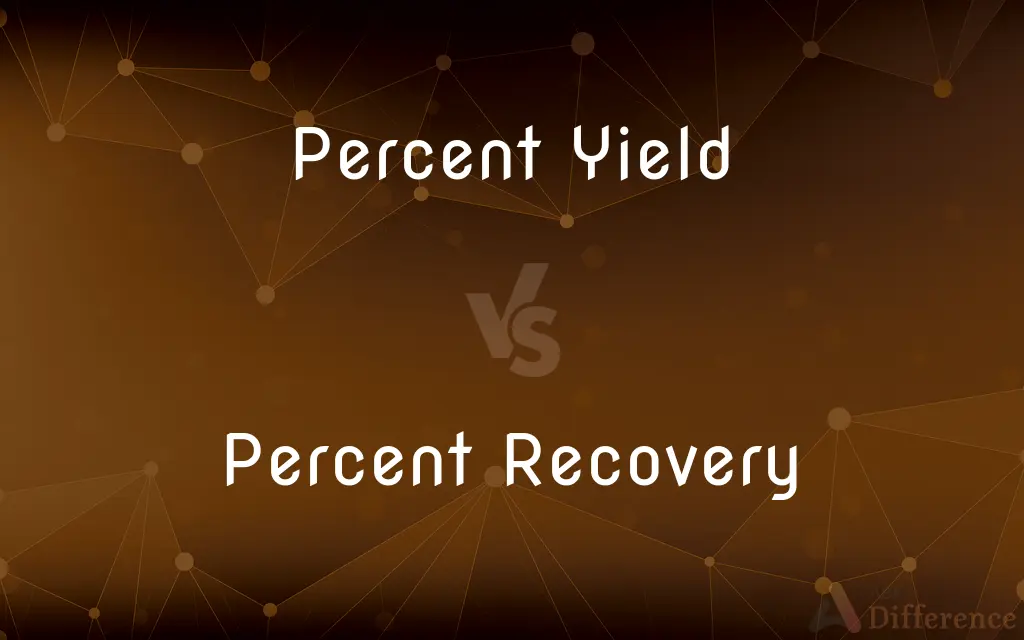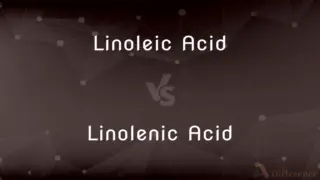Percent Yield vs. Percent Recovery — What's the Difference?
By Tayyaba Rehman — Published on November 7, 2023
Percent Yield: Actual yield as a percentage of theoretical yield. Percent Recovery: Amount recovered from a process as a percentage of the starting material.

Difference Between Percent Yield and Percent Recovery
Table of Contents
ADVERTISEMENT
Key Differences
Percent Yield and Percent Recovery, both pertain to output in chemical processes, yet they find their distinction in application and calculation. Percent Yield relates to the ratio of the actual yield of a reaction to the theoretical maximum yield, generally derived from stoichiometric calculations. Conversely, Percent Recovery pertains specifically to the quantity of a substance that is reclaimed or isolated from a mixture, expressed as a percentage of the initial amount.
Where Percent Yield typically addresses the efficiency and effectiveness of a chemical reaction, Percent Recovery mainly deals with the efficacy of a purification or isolation process. The former is quintessential for chemists in predicting the outcome of reactions and optimizing conditions, while the latter is vital for assessing the viability and efficiency of recovery and purification methods.
Interestingly, Percent Yield and Percent Recovery, despite their specific domains, could coincide in particular scenarios. Imagine a situation wherein a synthesized product (calculated percent yield) undergoes a purification process; the purity or recovery would then be expressed using percent recovery. Both parameters would crucially inform on the overall efficiency and success of the entire procedure.
In contexts of teaching and practical application, Percent Yield and Percent Recovery are indispensable yet distinguishable concepts. Percent Yield, being grounded in stoichiometry, allows chemists to gauge theoretical and actual outcomes of reactions. Percent Recovery, alternatively, provides a measure for the isolation processes' effectiveness, often in the context of experimental or industrial separations.
The essence of comprehending Percent Yield and Percent Recovery in chemistry is acknowledging their unified goal towards efficiency and yield optimization. Despite the former focusing on theoretical versus actual yield in reactions, and the latter spotlighting the efficiency in reclaiming substances, both serve as pivotal benchmarks in evaluating and refining chemical processes.
ADVERTISEMENT
Comparison Chart
Definition
Ratio of actual yield to theoretical yield.
Ratio of recovered substance to initial amount used.
Typical Application
Utilized in evaluating chemical reactions.
Used in assessing purification or isolation processes.
Calculation Basis
Based on theoretical (stoichiometric) calculations and actual yield.
Based on initial amount and quantity recovered post-process.
Contextual Relevance
Relevant in comparing theoretical and actual outcomes of reactions.
Relevant in measuring the efficacy of a separation or purification method.
Importance in Optimization
Key for optimizing reaction conditions and identifying limiting reactants.
Crucial for refining isolation processes and maximizing substance recovery.
Compare with Definitions
Percent Yield
It acts as a performance indicator of a reaction by comparing the obtained and possible yield.
The chemist optimized conditions to improve the percent yield from 70% to 90%.
Percent Recovery
It is a comparative measure of the quantity isolated against the initial quantity of a particular substance.
The scientists adjusted the method to achieve an impressive 95% percent recovery.
Percent Yield
Percent Yield quantifies how much of the theoretically calculable product was generated in the actual reaction.
While aiming for a high percent yield, the team focused on minimizing the loss of product.
Percent Recovery
Percent Recovery communicates the extent of material recovered from a mixture or reaction milieu.
The strategy achieved an admirable 88% percent recovery, minimizing material wastage.
Percent Yield
Percent Yield denotes the actual output of a reaction relative to its theoretical maximum.
With an 80% percent yield, we obtained less product than the theoretical maximum predicted by stoichiometry.
Percent Recovery
Percent Recovery describes how much of the original material can be retrieved following a separation process.
Despite meticulous processes, the percent recovery was only 60%, indicating some loss.
Percent Yield
Percent Yield illustrates the efficiency of converting reactants into products in a chemical process.
The low percent yield of 45% indicated that the reaction was not particularly efficient.
Percent Recovery
It is an indicator of the efficacy of a purification or isolation process, denoted in percentage.
A 90% percent recovery from the purification process indicated high efficiency.
Percent Yield
It is a metric, expressed in percentage, portraying the actual yield as a fraction of theoretical yield.
Despite the challenges, the procedure resulted in a remarkable 95% percent yield.
Percent Recovery
Percent Recovery reflects the proportion of a substance that is retrieved post-isolation relative to the initial amount.
With a 70% percent recovery, we reclaimed significantly less substance than was originally present.
Common Curiosities
Can Percent Yield exceed 100%?
No, Percent Yield should not exceed 100%, as it would imply obtaining more product than theoretically possible.
What is Percent Recovery used for?
Percent Recovery is used to assess the effectiveness of a process in isolating or purifying a substance, measured as a percentage of the initial amount.
How does a chemist improve Percent Yield?
To enhance Percent Yield, chemists may refine reaction conditions, concentrations, and utilize catalysts to drive the reaction toward desired products.
How can one maximize Percent Recovery?
Maximizing Percent Recovery might involve optimizing purification methods, minimizing loss during transfer, or employing alternative isolation techniques.
What does Percent Yield measure?
Percent Yield measures the actual yield obtained from a reaction as a percentage of the theoretical yield.
Why is Percent Yield important in chemical reactions?
Percent Yield is vital to understand reaction efficiency and to optimize conditions for maximum product formation.
Why would a scientist be concerned with Percent Recovery?
Scientists focus on Percent Recovery to ensure minimal material loss and to evaluate the efficacy of purification or isolation processes.
Is it possible for Percent Recovery to be above 100%?
Ideally, no, Percent Recovery should not surpass 100% as it indicates recovery exceeding the initial substance amount, which is logically implausible.
What could lead to a suboptimal Percent Recovery?
Insufficient separation, material adherence to surfaces, or procedural loss can negatively impact Percent Recovery.
Can Percent Yield and Percent Recovery be utilized in the same process?
Yes, Percent Yield and Percent Recovery can both be relevant in a process involving chemical reaction followed by a purification step.
What factors could cause a low Percent Yield in reactions?
Factors like incomplete reactions, side reactions, or loss during product isolation can result in low Percent Yield.
Share Your Discovery

Previous Comparison
IT vs. ICT
Next Comparison
Linoleic Acid vs. Linolenic AcidAuthor Spotlight
Written by
Tayyaba RehmanTayyaba Rehman is a distinguished writer, currently serving as a primary contributor to askdifference.com. As a researcher in semantics and etymology, Tayyaba's passion for the complexity of languages and their distinctions has found a perfect home on the platform. Tayyaba delves into the intricacies of language, distinguishing between commonly confused words and phrases, thereby providing clarity for readers worldwide.













































